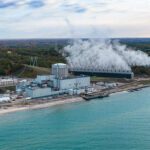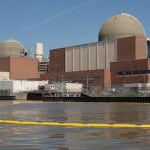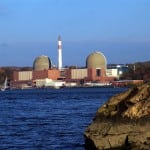One of the two remaining operating reactors at the Indian Point Energy Center in Buchanan, New York, will close for good on April 30, shutting down early as part of an agreement between Entergy, the plant’s operator, the state of New York, and environmental groups who had pressured officials to close the plant.
The 1,020-MW Unit 2 will close Thursday, leaving the 1,040-MW Unit 3 as the plant’s lone operating unit. Unit 3 is scheduled to close in April 2021 as part of the agreement, a deal reached in January 2017. The closure will mark the end of Entergy’s time as a participant in the merchant power business.
At the time of the 2017 agreement, Bill Mohl, president of Entergy Wholesale Commodities, said, “Key considerations in our decision to shut down Indian Point ahead of schedule include sustained low current and projected wholesale energy prices that have reduced revenues, as well as increased operating costs. In addition, we foresee continuing costs for license renewal beyond the more than $200 million and 10 years we have already invested.”
Not all environmental groups want Indian Point to close. The U.S.-based Climate Coalition in a letter delivered last week to New York Gov. Andrew Cuomo asked the governor to suspend the closure of the plant. The group, which includes climate scientists, environmental groups, climate and clean energy advocates, and others, said in the letter that closing the plant will make the state more vulnerable to power disruptions during the coronavirus pandemic.
The state urged Cuomo “to stop this poorly-timed closure and keep New York City’s 2-gigawatt, zero-emission, zero-air pollutant clean energy generation facility operational. Postponing the shutdown of Indian Point and preventing a surge of new, toxic fossil fuel pollutants from spewing into the air while people are perishing from respiratory failure, is probably the most critical, preventative thing you can do to ease suffering and additional deaths.”
Indian Point, located 24 miles from New York City, originally began commercial operation in 1962, with a single, 257-MW reactor; that Unit 1 was retired in 1974. Units 2 and 3 came online in 1974 and 1976, respectively.
Entergy purchased Unit 3 in 2000 from the New York Power Authority, and Unit 2—along with the permanently closed Unit 1—in 2001 from Consolidated Edison.
Plant Set for Decommissioning
Entergy in April 2019 said it would sell Indian Point to Comprehensive Decommissioning International, a Camden, N.J.-based jointly owned subsidiary of Holtec International, a company buying nuclear plants that are closed or scheduled for retirement. Holtec will take possession after the shutdown of Unit 3.
Holtec has proposed decommissioning and demolishing the facility by year-end 2033, at a projected cost of $2.3 billion. The company already has submitted a decommissioning report, which the Nuclear Regulatory Commission (NRC) said it put aside while the agency reviews the plant’s application to transfer the ownership license. Bruce Watson, chief of the Reactor Decommissioning Branch in the Division of Decommissioning Uranium Recovery and Waste Programs in the Office of Nuclear Materials Safety and Safeguards at the NRC, said a financial and technical review of Holtec’s capabilities will be done as the NRC reviews the application.
“We are evaluating Holtec’s technical and financial qualifications to decommission Indian Point,” said Watson in a media briefing April 21. “Such reviews typically take on the order of about a year; however, our review could be completed later this year.”
Richard Chang, a project manager in Watson’s office, at the briefing said Holtec’s plan calls for all spent fuel from Units 2 and 3 to be moved into dry cask storage as of early 2024. The spent fuel from Unit 1 already is in dry cask storage. Holtec expects to complete demolition of all three units at Indian Point by 2032, with site restoration expected to by the end of 2033.
“With respect to estimated costs, Holtec’s plan anticipates the cost of decommissioning Unit 1 as $598 million; Unit 2 as $702 million; and Unit three as over $1 billion, for a total of roughly $2.3 billion. Please note that these amounts include site restoration costs, which the NRC does not oversee. Our focus is on the radiological cleanup of the site,” said Chang. “As of the end of 2018, the decommissioning trust fund for Indian Point Unit 1 held $471 million; Indian Point 2 contained $598 million; and there was $780 million set aside for Indian Point Unit 3. The funds at that time added up to more than $1.85 billion.”
Groups Cite Problems at Plant
Environmental groups pressed for the plant’s closure citing Indian Point’s history of operational, safety, and environmental problems, which included a 2015 transformer fire that sent thousands of gallons of oil into the Hudson River. The groups also cited radioactive releases into groundwater and said the plant had inadequate disaster planning.
The New York Independent System Operator (NYISO), which oversees the state’s electric grid, last year said retiring Indian Point would not impact the reliability of the region’s power supply. NYISO said annual electricity demand in New York State has declined for more than a decade, and will remain essentially flat over the next 10 years. New York officials, including members of the state Public Service Commission (PSC), had looked at closing Indian Point even before the 2017 closure agreement, citing clean energy and energy efficiency initiatives that continue to grow the state’s use of renewable resources for power generation.
Those initiatives include 1.3 GW of demand response (DR) resources (programs that compensate customers for agreeing to cut their electricity use when called upon during high use periods) in place to cut electric power on peak summer days, along with additional capacity from retail DR programs approved by the PSC that are operated by Consolidated Edison and other utilities.
The state’s NY-Sun solar power program, launched in 2013, continues to ramp up solar projects on homes and businesses across the state. The state’s Climate Leadership and Community Protection Act (CLCPA), signed into law last year, mandates the installation of at least 6 GW of solar power in the state by 2025, along with 9 GW of offshore wind power by 2035.
Officials also have said the 1-GW TDI Champlain Hudson Power Express transmission project, which has been fully approved and permitted to bring hydropower from Quebec, Canada, to New York City, is likely to replace some of the generation lost from Indian Point’s closure.
Workers losing jobs due to the closure of Indian Point—the plant employed as many as 1,000 workers in recent years—could be helped by New York’s Cessation Mitigation Fund, created in 2015 to provide community support related to power plant shutdowns.
—Darrell Proctor is associate editor for POWER (@DarrellProctor1, @POWERmagazine).









